
Econometrics
Scope & Guideline
Unlocking the Potential of Econometric Methods
Introduction
Aims and Scopes
- Development of Econometric Models:
The journal emphasizes the creation and refinement of econometric models that can accurately capture economic relationships and dynamics. This includes traditional models as well as advanced techniques such as Bayesian methods, machine learning, and stochastic volatility models. - Application of Econometric Techniques:
Research published in the journal often involves applying econometric techniques to real-world data, covering various economic issues such as market forecasting, financial analysis, and policy evaluation. - Focus on Time Series and Panel Data:
A significant portion of the journal's content is dedicated to time series and panel data analysis, reflecting the importance of these methodologies in understanding economic trends and relationships over time. - Interdisciplinary Research:
The journal encourages interdisciplinary approaches, integrating insights from economics, finance, statistics, and data science to address complex economic questions. - Policy Relevance:
Many studies published in 'Econometrics' aim to inform economic policy by providing empirical evidence and analysis that can guide decision-making in various sectors.
Trending and Emerging
- Machine Learning in Econometrics:
There is a growing trend of incorporating machine learning techniques into econometric research, particularly for predictive modeling and data analysis, which allows for handling larger datasets and capturing complex patterns. - Causal Inference and Structural Models:
Research focusing on causal inference, particularly in the context of structural models, has gained traction, reflecting the increasing importance of identifying causal relationships in economics. - Impact of COVID-19 on Econometrics:
The pandemic has spurred a significant increase in studies analyzing its economic impact, utilizing innovative econometric approaches to assess various outcomes and inform policy responses. - High-Dimensional Data Analysis:
Emerging themes also include the analysis of high-dimensional data, which addresses the challenges posed by large datasets and the need for robust estimation techniques in econometrics. - Climate Change and Environmental Econometrics:
Research exploring the intersection of econometrics and climate change has become more prominent, indicating a growing recognition of environmental factors in economic modeling and policy analysis.
Declining or Waning
- Traditional Linear Models:
There has been a noticeable decline in studies focusing solely on traditional linear regression models, as researchers increasingly explore more complex and robust methodologies that account for non-linearity and other econometric challenges. - Basic Time Series Analysis:
The frequency of publications centered on basic time series analysis without advanced techniques has waned, as the field has moved towards more sophisticated methods that incorporate structural breaks, regime-switching, and multivariate approaches. - Static Economic Models:
Research based on static economic models has become less prominent, with a clear shift towards dynamic models that better capture the evolving nature of economic relationships and the impact of time-varying factors. - Descriptive Econometric Studies:
There has been a reduction in purely descriptive econometric studies that do not engage with advanced analytical techniques, as the journal's focus shifts towards more rigorous empirical research that offers deeper insights.
Similar Journals
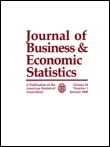
JOURNAL OF BUSINESS & ECONOMIC STATISTICS
Elevating Standards in Business and Economic ResearchJOURNAL OF BUSINESS & ECONOMIC STATISTICS is a premier academic journal published by Taylor & Francis Inc, dedicated to disseminating high-quality research in the fields of business, economics, and statistics. With an impressive impact in the academic community, the journal maintains a distinguished Q1 ranking across various categories including Economics and Econometrics, Social Sciences (miscellaneous), and Statistics and Probability, showcasing its relevance and influence in contemporary research. Since its inception in 1983, the journal has served as a vital resource for researchers, professionals, and students seeking insights into quantitative methodologies and their application in the economic domain. While the journal is not currently open access, its rigorous peer-review process ensures that published articles are of the highest scholarly standards. Researchers and practitioners alike will find a rich repository of empirical and theoretical studies that foster knowledge advancement in the intersecting realms of business, economics, and statistical analysis.
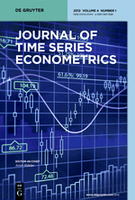
Journal of Time Series Econometrics
Exploring the Dynamics of Economic Data with PrecisionJournal of Time Series Econometrics, published by WALTER DE GRUYTER GMBH, serves as a pivotal platform for current research within the fields of Economics and Econometrics. With an ISSN of 2194-6507 and E-ISSN 1941-1928, this journal is dedicated to the advancement of time series analysis techniques and their practical application in economic contexts. Operating from Germany, the journal seeks to foster a vibrant intellectual environment, inviting contributions that push the boundaries of established theories and methodologies. With an established influence in academia, recent evaluations have placed the journal within the Q4 category in the 2023 rankings for Economics and Econometrics, alongside a notable 39th percentile ranking in Scopus. Although currently lacking open access options, the journal promotes crucial discussions and knowledge dissemination on innovative econometric practices. The period from 2016 to 2024 marks a significant phase of convergence in the journal's evolution, promising ongoing relevance and engagement for researchers, professionals, and students eager to explore the complexities of time series analysis and its implications within economic theory.
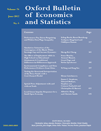
OXFORD BULLETIN OF ECONOMICS AND STATISTICS
Advancing economic insights through rigorous research.The Oxford Bulletin of Economics and Statistics, published by Wiley, stands as a leading journal in the realms of Economics, Econometrics, and Statistics. Since its inception in 1973 and converging through to 2024, the journal has consistently positioned itself in the top quartile (Q1) across multiple categories, including Economics and Econometrics, Social Sciences, and Statistics and Probability, highlighting its influential status in the academic community. With a commendable ranking within Scopus, notably ranked #53 in Social Sciences and #28 in Statistics and Probability, it serves as a critical platform for disseminating rigorous research and innovative methodologies. Researchers, professionals, and students are encouraged to contribute and engage with the high-quality content that defines this esteemed journal, which does not currently offer Open Access but remains a pivotal resource for those seeking to deepen their understanding of economic and statistical paradigms in the pressing global landscape.

Quantitative Economics
Driving innovation in economics through open-access research.Quantitative Economics is a leading open-access journal published by WILEY, dedicated to advancing the field of economics through rigorous quantitative analysis. Established in 2010 and based in the United States, this influential journal boasts an impressive Q1 rating in the 2023 category of Economics and Econometrics, reflecting its high impact and quality within the field. With a Scopus ranking of #222 out of 716 in the Economics and Econometrics category, it sits comfortably in the 68th percentile, underscoring its relevance to researchers and professionals alike. The journal accepts a wide range of submissions, including original research articles, methodological advancements, and comprehensive reviews, which contribute to the understanding and application of quantitative methods in economic research. By providing immediate open access to all published articles, Quantitative Economics ensures that vital findings are readily available to academics, policymakers, and students across the globe, enhancing collaboration and innovation within the discipline.
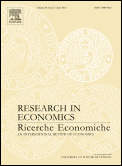
Research in Economics
Advancing economic thought through innovative research.Research in Economics, published by ELSEVIER SCI LTD, is a distinguished peer-reviewed journal that addresses pivotal issues in the field of economics and econometrics. Since its inception in 1997, the journal has provided a platform for innovative research and theoretical development, welcoming contributions that push the boundaries of traditional economic thought. With an ISSN of 1090-9443 and an E-ISSN of 1090-9451, it currently holds a respectable position in the Q3 category of the 2023 rankings for Economics and Econometrics. Despite its current Scopus rank of #500 out of 716, representing the 30th percentile, the journal continues to cultivate a rich community of researchers, practitioners, and students dedicated to advancing economic knowledge. While it operates without an Open Access option, the journal remains committed to disseminating high-quality research that informs both academic scholarship and practical applications in the economic landscape.
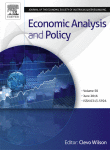
Economic Analysis and Policy
Leading the Way in Economic Insights and Policy DevelopmentEconomic Analysis and Policy is an esteemed academic journal published by ELSEVIER, dedicated to advancing the field of economics and econometrics since its inception in 1970. Based in the Netherlands, this journal plays a pivotal role in disseminating high-quality research that addresses contemporary economic issues and policy challenges. With an impressive Q1 ranking in both the Economics and Econometrics categories, and recognition in the top 91st percentile of Scopus rankings, it is a leading platform for scholars, professionals, and students seeking to contribute to and engage with the evolution of economic thought. The journal does not currently operate on an open access model, allowing it to maintain rigorous peer-review standards that ensure the integrity and impact of published research. As a vital resource for anyone interested in the intersection of theory and policy in economics, Economic Analysis and Policy fosters a community committed to rigorous analysis and innovative solutions in the economic domain.
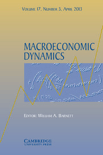
MACROECONOMIC DYNAMICS
Advancing Insights into Economic ComplexityMACROECONOMIC DYNAMICS, a distinguished academic journal published by Cambridge University Press, serves as a pivotal platform for innovative research in the fields of economics and econometrics. With its ISSN 1365-1005 and E-ISSN 1469-8056, the journal has been at the forefront of scholarly communication since its inception in 1997, offering an extensive range of articles that explore dynamic economic models, policy impacts, and theoretical advancements through the latest empirical analyses. Currently holding a Q2 ranking within the 2023 Economics and Econometrics category, and positioned at rank #409 out of 716 within Scopus, it is an essential resource for researchers, professionals, and students alike, looking to stay updated on critical developments in macroeconomic theory and practice. Although it follows a traditional subscription model rather than Open Access, the journal continually strives to disseminate high-quality, peer-reviewed content that informs and inspires the global economics community. The importance of MACROECONOMIC DYNAMICS lies in its commitment to fostering a deeper understanding of economic phenomena, making it a must-read for anyone engaged in the complexities of the economic landscape.
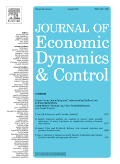
JOURNAL OF ECONOMIC DYNAMICS & CONTROL
Unveiling Insights in Applied Mathematics and EconometricsJOURNAL OF ECONOMIC DYNAMICS & CONTROL, published by Elsevier, is a distinguished scholarly journal that has established itself as a leading outlet in the fields of applied mathematics, control and optimization, and economics and econometrics since its inception in 1979. With its notable Q1 categorization in 2023 across these disciplines, this journal provides a platform for innovative research that propels theory and practice in dynamic systems and control processes. Researchers, professionals, and students can engage with cutting-edge studies that explore complex economic models and their real-world applications. Although the journal does not offer open access, it remains a vital resource for those aiming to stay informed of the latest advancements in economic dynamics and control methodologies. The journal’s commitment to high-quality research and its impressive standing—ranked in the top percentiles within Scopus categories—underscore its importance and influence within the academic community.
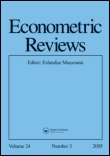
Econometric Reviews
Advancing Economic Insights Through Rigorous AnalysisEconometric Reviews, published by Taylor & Francis Inc, is a premier journal in the field of Economics and Econometrics, recognized for its significant contributions to the advancement of economic theory and practice since its inception. With its ISSN 0747-4938 and E-ISSN 1532-4168, the journal has maintained a consistent publication record from 1982 to 2024, offering a platform for groundbreaking research that shapes the landscape of quantitative economic analysis. With a proud place in the Q1 category for Economics and Econometrics as of 2023, it stands as a critical resource for scholars, practitioners, and students alike, actively engaging with themes such as econometric methods, theory, and policy implications. Although operating under a subscription model, the journal’s high impact factor reflects its esteem within the academic community, fostering a rich dialogue among researchers in this evolving discipline. The journal’s office is located at 530 Walnut Street, Ste 850, Philadelphia, PA 19106, USA, forging connections in one of the central hubs of economic research.

Ekonomika i Matematiceskie Metody-Economics and Mathematical Methods
Unveiling the Synergy of Economics and Mathematical MethodsEkonomika i Matematiceskie Metody - Economics and Mathematical Methods is a distinguished journal published by the esteemed Russian Academy of Sciences and the State Academy of Humanities (GAUGN). It serves as a vital resource in the interdisciplinary field of economics and mathematical applications, focusing on advanced theories, methodologies, and quantitative techniques that drive economic research and practice. With an ISSN of 0424-7388, this journal is geared towards researchers, professionals, and students who seek to contribute to the evolving landscape of economic theory and mathematics. Although the journal does not currently offer open access, it remains committed to fostering rigorous academic discourse. Through its insightful articles, Ekonomika i Matematiceskie Metody plays a crucial role in disseminating influential concepts and methodologies, making it an essential publication within the realm of economic sciences.